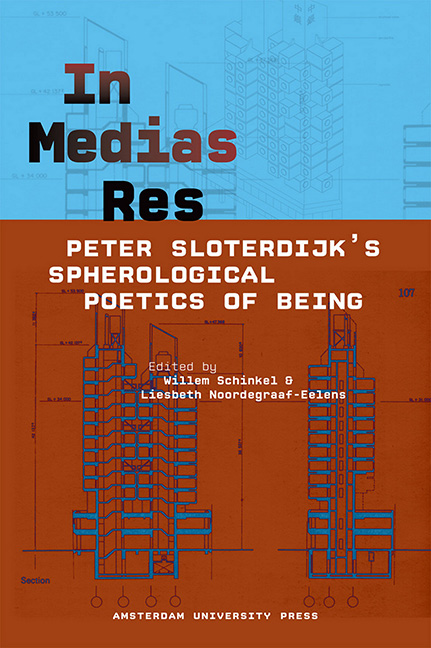Book contents
- Frontmatter
- Contents
- 1 Peter Sloterdijk’s Spherological Acrobatics: An Exercise in Introduction
- 2 Foamy Business: On the Organizational Politics of Atmospheres
- 3 “Transgenous Philosophy”: Post-humanism, Anthropotechnics and the Poetics of Natal Difference
- 4 Disinhibition, Subjectivity and Pride. Or: Guess Who Is Looking?: Peter Sloterdijk’s reconstruction of ‘thymotic’ qualities, psychoanalysis and the question of spectatorship
- 5 Sloterdijk and the Question of an Aesthetic
- 6 Uneasy Places. Monotheism, Christianity, and the Dynamic of the Unlikely in Sloterdijk’s Work – Context and Debate
- 7 The Attention Regime: On Mass Media and the Information Society
- 8 In the Beginning was the Accident: The Crystal Palace as a Cultural Catastrophe and the Emergence of the Cosmic Misfit: A critical approach to Peter Sloterdijk’s Weltinnenraum des Kapitals vs. Fyodor M. Dostoevsky’s Notes from the underground
- 9 A Cautious Prometheus? A Few Steps Toward a Philosophy of Design with Special Attention to Peter Sloterdijk
- 10 Sloterdijk and the Question of Action
- 11 The Space of Global Capitalism and its Imaginary Imperialism: An Interview with Peter Sloterdijk
- Contributors
- Index
1 - Peter Sloterdijk’s Spherological Acrobatics: An Exercise in Introduction
Published online by Cambridge University Press: 23 June 2021
- Frontmatter
- Contents
- 1 Peter Sloterdijk’s Spherological Acrobatics: An Exercise in Introduction
- 2 Foamy Business: On the Organizational Politics of Atmospheres
- 3 “Transgenous Philosophy”: Post-humanism, Anthropotechnics and the Poetics of Natal Difference
- 4 Disinhibition, Subjectivity and Pride. Or: Guess Who Is Looking?: Peter Sloterdijk’s reconstruction of ‘thymotic’ qualities, psychoanalysis and the question of spectatorship
- 5 Sloterdijk and the Question of an Aesthetic
- 6 Uneasy Places. Monotheism, Christianity, and the Dynamic of the Unlikely in Sloterdijk’s Work – Context and Debate
- 7 The Attention Regime: On Mass Media and the Information Society
- 8 In the Beginning was the Accident: The Crystal Palace as a Cultural Catastrophe and the Emergence of the Cosmic Misfit: A critical approach to Peter Sloterdijk’s Weltinnenraum des Kapitals vs. Fyodor M. Dostoevsky’s Notes from the underground
- 9 A Cautious Prometheus? A Few Steps Toward a Philosophy of Design with Special Attention to Peter Sloterdijk
- 10 Sloterdijk and the Question of Action
- 11 The Space of Global Capitalism and its Imaginary Imperialism: An Interview with Peter Sloterdijk
- Contributors
- Index
Summary
Peter Sloterdijk is a morphological thinker. He thinks morphologies and his thinking continually morphs. He is interested in life forms, in the forms of collectivity, and in the collective forms of individuality. He just as soon analyzes the intra-uteral life of the unborn child as he does the space of the apartment-dweller. He finds in Ficino's rendition of the visual field just as many indications of a being-in-spheres as in the 15th and 16th century discovery of the sea as the primary medium of modern being. Sloterdijk's work can be said to have a certain cosmogonic character. After the Fall, man stands naked and in need of inventing life forms that cover him, in which he can be immersed. The great metaphysical buildings of antiquity and Christianity were life forms providing existential shelter in the form of spheres of socio-spatial co-existence. But they have lost credibility, and we are back out in the open, naked. According to Sloterdijk, the topological message of modernity is: “that people are living beings, living at the edge of an uneven round body – a body which, as a whole, is neither a mother's body nor a container, and which has no protection to offer”. In Sloterdijk's diagnosis, if one could call it that, something of the existential despair of Pascal shines through: we realise we are afloat in a meaningless universe, crawling a tiny globe that has been dethroned, cast from centre to periphery. But there is also Voltaire's scepticism and humour: the same situation can be described in terms of the Micromégas, arrogantly roaming the globe. Then again, there is in Sloterdijk a Nietzschean energy, a positive affirmation of this situation, and a continuous call to invent new ways of forming life. For like in Hannah Arendt's conception of ‘natality’, being is a continuous coming-into-the-world (zur Welt kommen). In his recent work, that is accompanied by a constructive call: Sloterdijk turns Rilke's ‘du mußt dein Leben ändern’ into the positive challenge of an existential acrobatics. The art of life is a morphological art, an acrobatic act of constituting collective spheres whilst balancing over a crevice on Nietzsche's rope between animal and overman. And it is in such intermediary zones that new life forms come to be constituted through practice and training.
- Type
- Chapter
- Information
- In Medias ResPeter Sloterdijk's Spherological Poetics of Being, pp. 7 - 28Publisher: Amsterdam University PressPrint publication year: 2012

